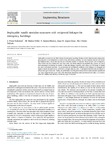Mostrar o rexistro simple do ítem
Deployable Bundle Modulus Structures With Reciprocal Linkages for Emergency Buildings
| dc.contributor.author | Pérez-Valcárcel, Juan | |
| dc.contributor.author | Muñoz-Vidal, Manuel | |
| dc.contributor.author | Suárez-Riestra, Félix | |
| dc.contributor.author | López-César, Isaac | |
| dc.contributor.author | Freire-Tellado, Manuel J. | |
| dc.date.accessioned | 2021-10-25T11:45:02Z | |
| dc.date.available | 2021-10-25T11:45:02Z | |
| dc.date.issued | 2021-10-01 | |
| dc.identifier.citation | J. Pérez-Valcárcel, M. Muñoz-Vidal, F. Suárez-Riestra, Isaac R. López-César, M.J. Freire-Tellado, Deployable bundle modulus structures with reciprocal linkages for emergency buildings, Engineering Structures, Volume 244, 2021, 112803, ISSN 0141-0296, https://doi.org/10.1016/j.engstruct.2021.112803. (https://www.sciencedirect.com/science/article/pii/S0141029621009536) | |
| dc.identifier.issn | 0141-0296 | |
| dc.identifier.uri | http://hdl.handle.net/2183/28714 | |
| dc.description | Financiado para publicación en acceso aberto: Universidade da Coruña/CISUG | |
| dc.description.abstract | [Abstract] Deployable structures are an ideal solution for emergency buildings because of their lightness and compactness, allowing them to be transported to wherever they are needed. Generally the most frequent solutions use Scissor-like-Elements (SLE), but in this case the use of bundle modules is proposed. These systems were developed by Pérez Piñero, but have hardly been used since then. The article analyses the problems they present, as well as their advantages in reducing the number of bars and linkages required, which allows for the design of simpler and more economical structures. The geometrical and mechanical conditions of the linkages for triangular and square modules are analysed, as well as the typologies that may arise. A calculation method is also developed to analyse this type of structure. Finally, the performance of a flat grid is analysed in an analytical and experimental way using reciprocal links at its ends. Both theoretical calculations and experimental tests allow us to demonstrate the viability and efficiency of this new type of structure. | es_ES |
| dc.description.sponsorship | This study is part of the research project “Deployable and modular constructions for situations of humanitarian catastrophe”, funded by the Ministry of Economy and Competitiveness of the Kingdom of Spain with reference BIA2016-79459-R | es_ES |
| dc.language.iso | eng | es_ES |
| dc.publisher | Elsevier | es_ES |
| dc.relation | info:eu-repo/grantAgreement/AEI/Plan Estatal de Investigación Científica y Técnica y de Innovación 2013-2016/BIA2016-79459-R/ES/CONSTRUCCIONES DESPLEGABLES Y MODULARES PARA SITUACIONES DE CATASTROFE HUMANITARIA | |
| dc.relation.uri | https://doi.org/10.1016/j.engstruct.2021.112803 | es_ES |
| dc.rights | Atribución-NoComercial-SinDerivadas 4.0 Internacional | es_ES |
| dc.rights.uri | http://creativecommons.org/licenses/by-nc-nd/4.0/ | * |
| dc.subject | Deployable structures | es_ES |
| dc.subject | Bundle modulus | es_ES |
| dc.subject | Reciprocal linkages | es_ES |
| dc.subject | Lightweight structures | es_ES |
| dc.subject | Temporary buildings | es_ES |
| dc.subject | Emergency buildings | es_ES |
| dc.title | Deployable Bundle Modulus Structures With Reciprocal Linkages for Emergency Buildings | es_ES |
| dc.type | info:eu-repo/semantics/article | es_ES |
| dc.rights.access | info:eu-repo/semantics/openAccess | es_ES |
| UDC.journalTitle | Engineering Structures | es_ES |
| UDC.volume | 244 | es_ES |
| UDC.startPage | 112803 | es_ES |
| dc.identifier.doi | 10.1016/j.engstruct.2021.112803 |
Ficheiros no ítem
Este ítem aparece na(s) seguinte(s) colección(s)
-
GI-GEA - Artigos [62]






